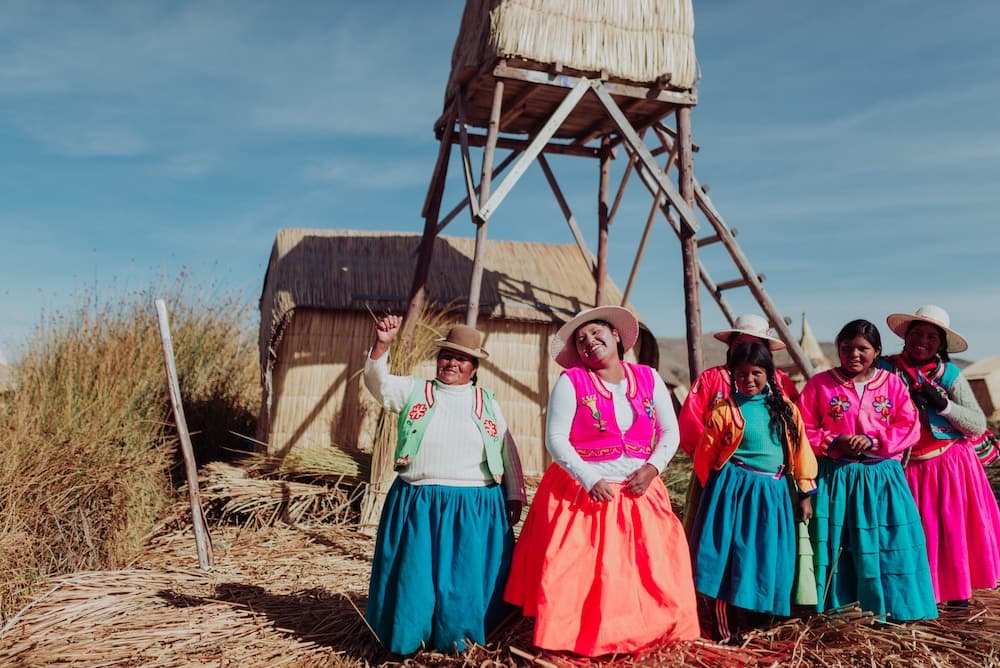The Uros Islands: A unique and Eco-Friendly experience on lake Titicaca
Disclosure: Bear in mind that some of the links in this post are affiliate links and if you go through them to make a purchase we will earn a commission at no additional cost to you. We chose these companies / hotels because of their quality and not because of the commission we receive from your purchases.
Lake Titicaca, located on the border of Peru and Bolivia, is the highest navigable lake in the world and the biggest lake in South America. With a unique community of indigenous people known as the Uros, the lake is surrounded by snow-capped mountain peaks and offers stunning views of islets and floating villages.
The Uros people have been living on floating islands made of reeds in the middle of the lake for centuries. Although the water is freezing, visitors can enjoy a refreshing swim in the heart of the Andes and reach greater heights than they ever will elsewhere.
The setting of Lake Titicaca is simply stunning. The lake covers an area of 8,340 square kilometers. There are approximately 25 rivers and streams that drain into Lake Titicaca's basin, but the lake's water level is mainly maintained by precipitation, underground springs, and glaciers due to the fact that the rivers are mostly blocked by the surrounding mountain walls.
The primal city of Puno on the Peruvian west side of the lake serves as a base for boat tours. Most tours first visit the floating islands of the Uros Indians and then the islets of Taquile and Amantani. Visitors can also trek from Puno to Copacabana in Bolivia on the other side of the lake. 
While the floating islands of the Uros are a fascinating sight, visitors should be wary of mass tourism. Some local entrepreneurs have taken advantage of the Uros Indians by bringing many tourists without permission. To avoid this, visitors can talk to the harbor masters at the port in Puno and take their own ferry to the floating Uros islands. This way, visitors can interact with the islanders, who are happy to explain the islands, their inhabitants, and the local culture. 
Sun and Moon island
The Sun Island (Isla del Sol) and the Moon Island (Isla de la Luna) are beautiful places to hike. The Moon Island is a very small island and is mainly visited because of some ancient Inca ruins.
The Sun Island, on the other hand, is much larger and has many tourists. Visitors can take a walk around the island past ruins and coca fields, but be aware that the climb is steep and can take 2-3 hours. Once at the top, visitors are rewarded with a beautiful view.
Facilities on the islands are scarce, and to visit them, visitors must cross the border into Bolivia, which takes around two hours from Puno. The rustic Taquile, a small island where locals live mainly from agriculture, is a much more beautiful alternative. Visitors can walk around at their leisure and learn about the culture and customs of the inhabitants. For those with more time, Amantani is located a little further into the lake, and visitors can spend the night on the island.
Best time to visit
The best time to visit Lake Titicaca is during the dry season, which runs from May to October. During this period, the weather is generally clear and sunny, and the temperature is mild during the day but can drop to near freezing at night. From November to April, the rainy season brings colder temperatures and cloudy skies, but it's still possible to visit the lake during this time.
Where to stay
If you're looking for an eco-friendly and luxurious place to stay in the region, consider the Titilaka - Relais & Châteaux, located on the shores of Lake Titicaca 36 km (22 miles) outside of Puno. The lodge is dedicated to sustainable tourism practices and offers a variety of eco-friendly activities, such as bird watching, hiking, and stargazing.

With just 18 rooms, each with panoramic views of the lake, the lodge has a range of amenities, including a spa, a gourmet restaurant, and a bar. The lodge also supports the local community by using locally sourced ingredients in their meals and hiring staff from the surrounding area.
In summary, Lake Titicaca is a stunning destination that offers breathtaking views, a unique community of indigenous people, and a chance to swim higher than ever before. While mass tourism has had an impact on the floating islands of the Uros, visitors can still interact with the islanders by talking to the harbor masters at the port in Puno. A visit to Taquile or Amantani is a must for those who want to explore the lake further and learn about the culture and customs of the inhabitants.